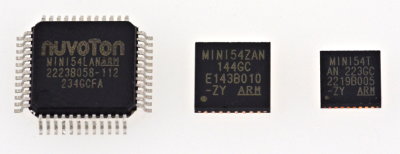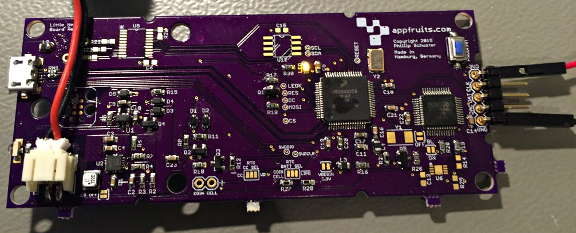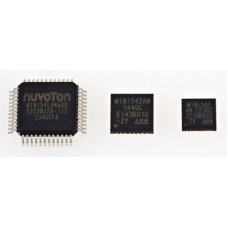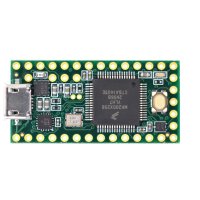Product code:
| IC_MINI54_TQFP |
By using this Mini54 chip and a blank MK20DX128VLH5 or MK20DX256VLH7, you can build your own Do-It-Yourself board that's compatible with Teensyduino and Teensy Loader. Either chip will work. The MINI54 will automatically detech which chip you've used and implement either Teensy 3.0 or Teensy 3.1.
These chips can also be very useful for modest volume production of a fully custom product developed using Teensy 3.0 or Teensy 3.1.

Required Connections:
--------------------
TQFP QFN Signal MK20XXX Pin
---- --- ------ -----------
38 26 P0.0 MK20 Pin 23 (PTA1)
33 22 P0.6 MK20 Pin 25 (PTA3)
34 23 P0.5 MK20 Pin 25 (PTA3)
32 21 P0.7 MK20 Pin 22 (PTA0)
37 25 P0.1 MK20 Pin 24 (PTA2)
9 7 P3.4 MK20 Pin 38 (PTB3)
10 8 P3.5 MK20 Pin 37 (PTB2)
8 6 P3.2 MK20 Pin 34 (Reset)
20 13 P5.2 Program Pushbutton
42 28 VDD +3.3V
43 AVDD +3.3V (TQFP only)
25 17 P2.5 Ground
47 32 P1.4 Ground
17 12 VSS Ground
5 AVSS Ground (TQFP only)
18 LDOCAP 0.1uF Capacitor to Ground (TQFP only)
33 VSS Ground (QFN only, connect center pad to ground)
All other MINI54 pins should be left unconnected
Examples
Philip Schuster has published a custom board reference design in Eagle format, and a helpful writeup. If you have the professional version of Eagle, his files may help you get started.

Crystal Guidelines
Teensy 3.1 requires a 16 MHz crystal with a parallel load capacitance spec of 8 to 10 pF.If an 18 pF rated crystal is used, two 20 pF capacitors should be added to the design.
The crystal should be located close to the MK20 chip. A ground plane should be placed underneath the crystal. If using a 2 layer PCB design, the ground plan for the crystal should NOT make any other connections to ground, other than the crystal case ground, capacitor grounds (if adding extra capacitance) and to the ground pin next to the crystal pins.
Never route any digital signal directly underneath the crystal (if disregarding the ground plane advice). PCB designs that violate these rules have experienced crashes or unreliable operation due to digital signals disrupting the crystal.
Avoid routing fast digital signals in parallel with either crystal trace. Normally this is a non-issue, because ground is on one side of the crystal pins and RESET is on the other side (RESET is safe, because it's held as a DC voltage while the chip runs). Fast digital signals can capacitively couple to either crystal signal, causing the oscillator stop or jitter, which can be particularly problematic if the internal phase-locked-loop is using the crystal as its timing reference.
Poor crystal layout has caused several custom PCB designs to fail. Be careful with the crystal layout!
Troubleshooting
Here are conversations from people who've used the MINI54 to build their own boards. Many bits of troubleshooting advise and details are available in these forum threads!Diagnosing an unresponsive board. This discussion has details about how to check if the MK20 and MINI54 chips are alive. If you use a contract manufacturer, make sure they do not buy & use blank MINI54 chips!
Component details, particularly layout guidelines for the crystal.
VREGOUT on the MK20 must be connected, even if you are supply 3.3V without using the MK20's built in voltage regulator.
Good decoupling is needed on the 3.3V line. Two people confirmed their boards started working with more/better capacitors on the 3.3V power.
Pins shorted together obviously can cause trouble. If using a contract manufacturer to assemble prototypes, make more than one board. Two or more for each comparison can help reduce chances a random construction error ruins your otherwise perfect design.
Swapping the D+ and D- signals on the USB connector causes a board with a Program and Reset signal both responding to the pushbutton (a sure sign the Mini54 works) to never actually communicate with Teensy Loader.
VBAT must be connected, even if the RTC feature is never used. When VBAT lacks power, a board may be detected by Teensy Loader and appear to program correctly, but won't actually boot up and reappear as a serial device or whatever other type was selected in Tool > USB Type when compiling the code.
Missing power connections on a connector between a 2-board design can cause really confusing problems.
Please understand the crystal start oscillating under software control. The oscillator is NOT automatically enabled at power-up or reset. It is perfectly normal for the crystal to not oscillate while the MK20 is held in reset state or before software activates the oscillator. The MK20 always boots up to a mode where it runs from an internal RC oscillator.
MINI54 Chip With Pre-Programmed Teensy 3.0 Bootloader
- Brand: PJRC
- Product Code: PJRC-Mini54-Chip
- Reward Points: 12
- Availability: In Stock
- रo 1,160.00
-
रo 956.00
- Price in reward points: 1160
Available Options
Related Products
Teensy 3.2
Teensy 3.2 features a 32 bit ARM processor. Teensy 3.2 is a direct, 100% compatible replacement ..
रo 1,730.00 रo 2,005.00
Tags: MINI54, Chip, Pre-Programmed, Teensy 3.0



